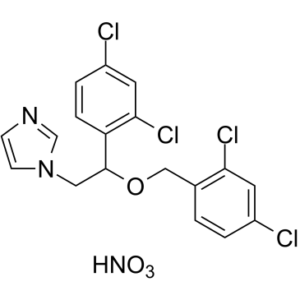Miconazole nitrate (R18134 nitrate)
This product is for research use only, not for human use. We do not sell to patients.

For small sizes, please check our retail website as below: www.invivochem.com
| Size | Price | Stock |
|---|---|---|
| 50g | $450 | Check With Us |
| 100g | $750 | Check With Us |
| 200mg | $1125 | Check With Us |
Cat #: V25514 CAS #: 22832-87-7 Purity ≥ 99%
Description: Miconazole nitrate (R18134 nitrate) is an 14-α demethylase inhibitor and potential glucocorticoid receptor antagonist that inhibits ergosterol synthesis and fungal cell wall formation.
Top Publications Citing Invivochem Products
Publications Citing InvivoChem Products
Product Promise

- Physicochemical and Storage Information
- Protocol
- Related Biological Data
- Stock Solution Preparation
- Quality Control Documentation
| Molecular Weight (MW) | 479.13 |
|---|---|
| Molecular Formula | C18H15Cl4N3O4 |
| CAS No. | 22832-87-7 |
| Synonyms | Andergin; Deralbine; Florid; Micatin; R 14889; R14889; R-14889 |
| Protocol | In Vitro | Miconazole nitrate (R18134 nitrate) is an imidazole antifungal agent developed by Janssen Pharmaceutica and usually applied topically to the skin or mucous membranes to treat fungal infections. It works by inhibiting the synthesis of ergosterol, an important component of fungal cell membranes. It can also be used against certain species of Leishmania, a single-celled parasite whose cell membranes also contain ergosterol. In addition to its antifungal and antiparasitic effects, it has some antibacterial properties. Nitric acid Miconazole nitrate (R18134 nitrate) is also used for the development of Ektachrome film in final processing of the Kodak E-6 process and similar Fujifilm CR-56 process to replace formaldehyde. Fuji Hunt also added miconazole as a final rinse additive to the formulation of its C-41RA Quick Access Color Negative Development Process. From Wikipedia. |
|---|
These protocols are for reference only. InvivoChem does not
independently validate these methods.
| Solvent volume to be added | Mass (the weight of a compound) | |||
|---|---|---|---|---|
| Mother liquor concentration | 1mg | 5mg | 10mg | 20mg |
| 1mM | 2.0871 mL | 10.4356 mL | 20.8712 mL | 41.7423 mL |
| 5mM | 0.4174 mL | 2.0871 mL | 4.1742 mL | 8.3485 mL |
| 10mM | 0.2087 mL | 1.0436 mL | 2.0871 mL | 4.1742 mL |
| 20mM | 0.1044 mL | 0.5218 mL | 1.0436 mL | 2.0871 mL |
The molarity calculator equation
Mass(g) = Concentration(mol/L) × Volume(L) × Molecular Weight(g/mol)
Mass
=
Concentration
×
Volume
×
Molecular Weight*
The dilution calculator equation
Concentration(start)
×
Volume(start)
=
Concentration(final)
×
Volume(final)
This equation is commonly abbreviated as: C1 V1 = C2 V2
Concentration(start)
C1
×
Volume(start)
V1
=
Concentration(final)
C2
×
Volume(final)
V2
Step One: Enter information below
Dosage mg/kg
Average weight of animals g
Dosing volume per animal µL
Number of animals
Step Two: Enter the in vivo formulation
%DMSO
+
%
+
%Tween 80
+
%ddH2O
Calculation Results:
Working concentration:
mg/ml;
Method for preparing DMSO master liquid:
mg
drug pre-dissolved in
µL
DMSO(Master liquid concentration
mg/mL)
,Please contact us first if the concentration exceeds the DMSO solubility of the batch of drug.
Method for preparing in vivo formulation:
Take
µL
DMSO master liquid, next add
µL
PEG300, mix and clarify, next add
µL
Tween 80,mix and clarify, next add
µL
ddH2O,mix and clarify.
Note:
- (1) Please be sure that the solution is clear before the addition of next solvent. Dissolution methods like vortex, ultrasound or warming and heat may be used to aid dissolving.
- (2) Be sure to add the solvent(s) in order.




































